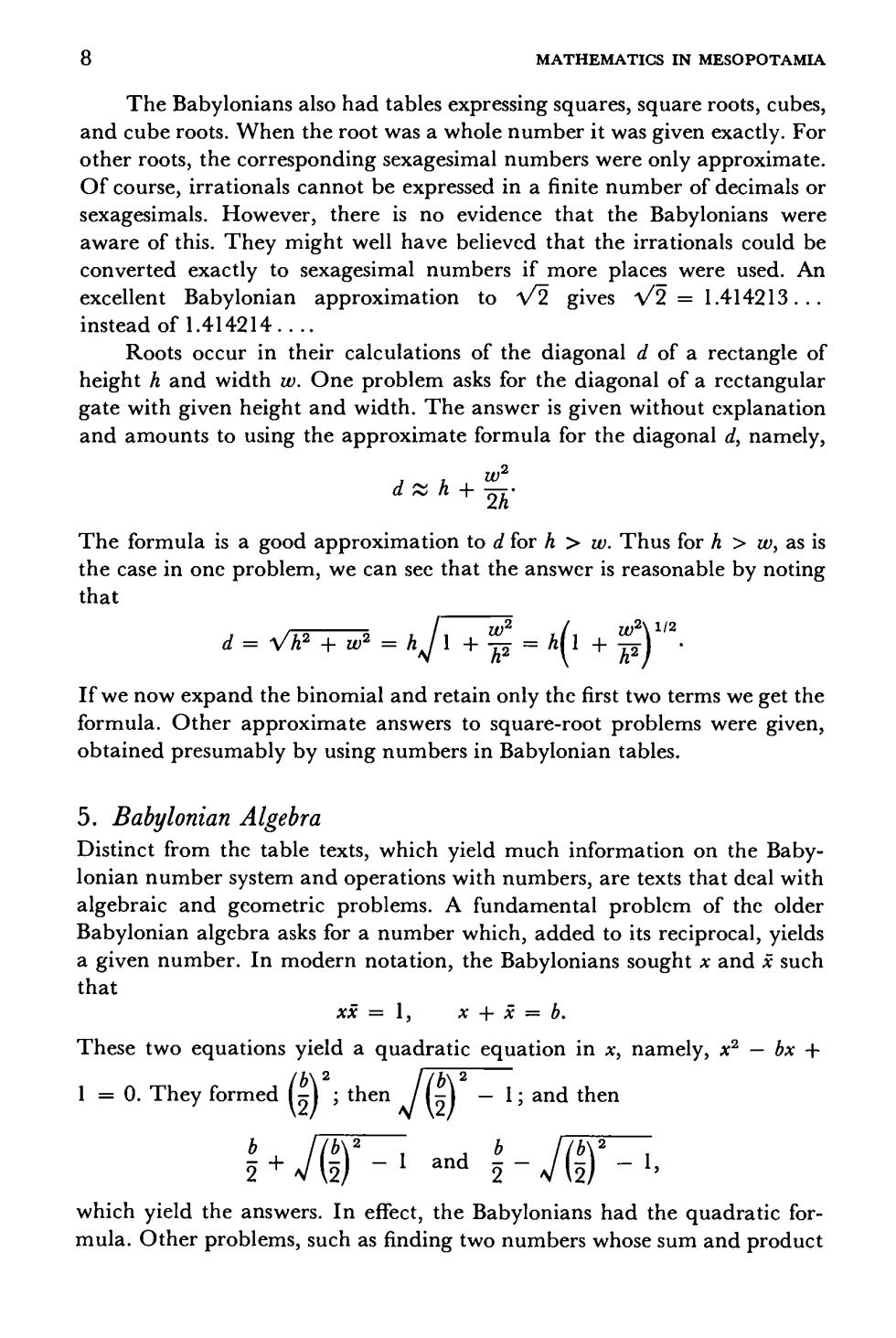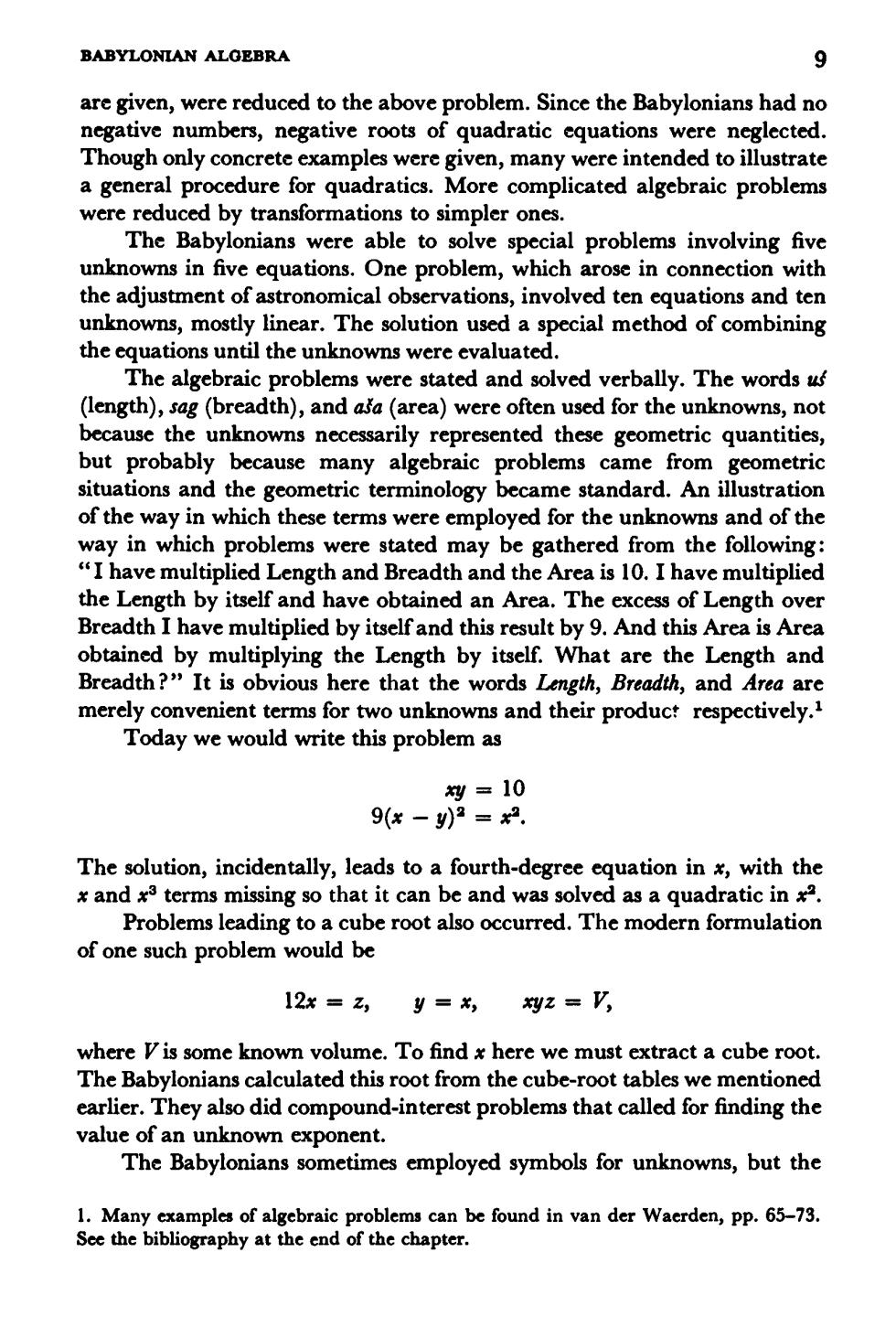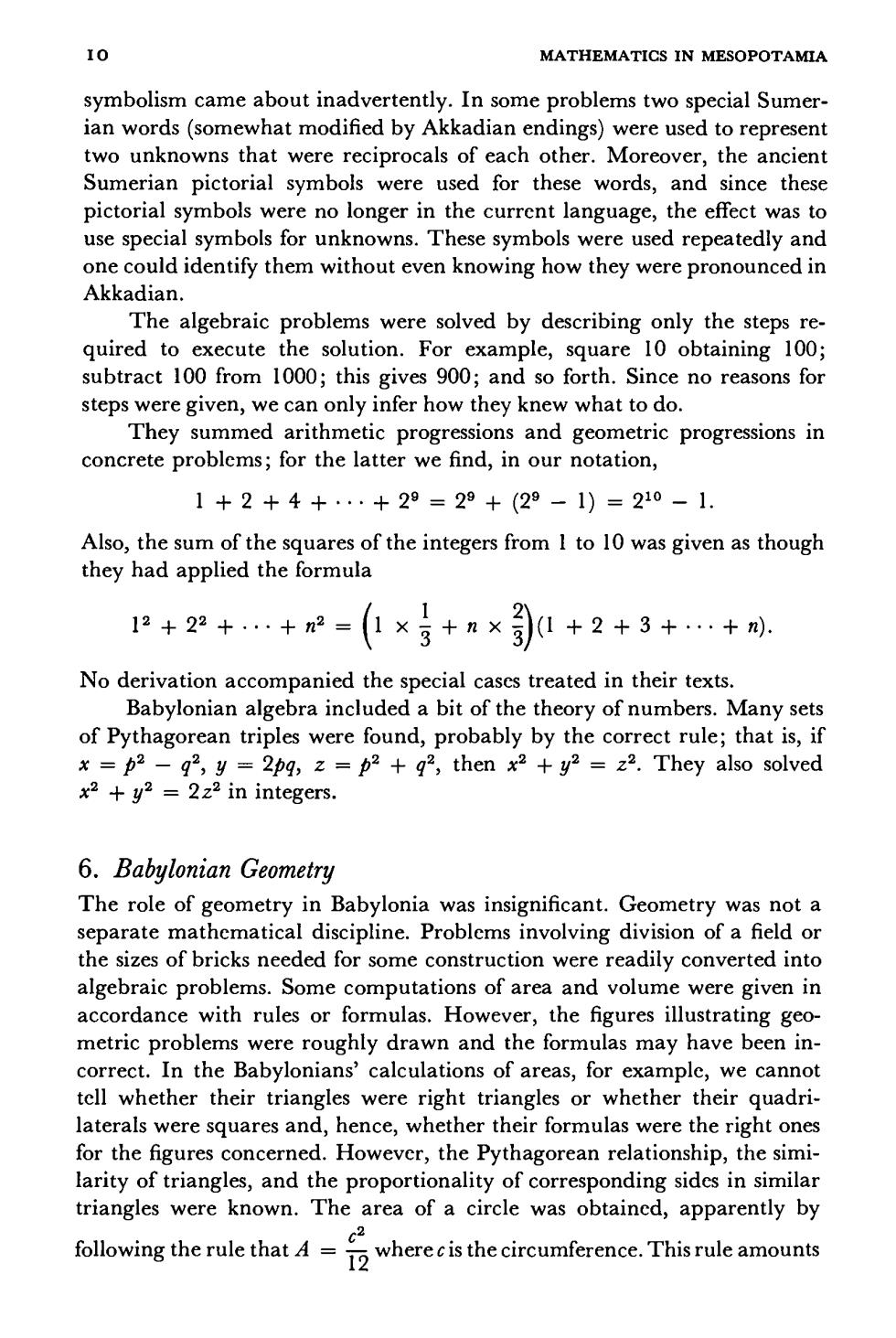
ARITHMETIC OPERATIONS became the denotation of a multiple of 60.Another possible explanation comes from the coinage system.One talent and 10 mana may have been written,where the meant I talent,which is 60 mana.We do the same when we write $1.20 and mean 100 cents by the 1.The scheme for writing amounts of money may then have been taken over to arithmetic generally. 4.Arithmetic Operations In the Babylonian system the symbols for I and 10 were basic.Numbers from 1 to 59 were formed by combining fewer or more of these symbols.Hence the processes of addition and subtraction were merely a matter of adding or taking away symbols.To indicate addition the Babylonians joined numbers together as in,which indicates 16.Subtraction was often indicated by the symbol is 40-3.In astronomical texts of a later period the word appears,signifying addition. Multiplication of integers was also performed.To multiply by 37,say, would mean multiplying by 30,then by 7,and adding the results.The symbol for multiplication was ,pronounced a-rd.It meant“togo.” The Babylonians divided one whole number by another.Since to divide by an integer a is to multiply by the reciprocal 1/a,to this extent fractions were involved.The Babylonians converted the reciprocals to sexagesimal "decimals"and,except for the few mentioned above,did not use special symbols for fractions.They had tables showing how numbers of the form I/a, where a=235.could be written as terminating sexagesimal numbers. Some tables gave approximate values for 1/7,1/11,1/13,etc.,because these fractions led to infinite repeating sexagesimals.Where fractions involving denominators other than 2,3,or 5 occurred in the older problems,the same troublesome factors occurred in the numerator and were cancelled. The Babylonians relied entirely upon the tables of reciprocals.Their tables show,for example, igi2 gdl-bi 30 igi 8 gal-bi 7,30 igi 3 gdl-bi 20 igi 9 gal-bi 6,40 igi4 gal-bi15 igi 6 gal-bi 10 igi27l-bi2,13,20 obviously meaning 1/2 =30/60,1/3 =20/60,etc.The precise meanings of igi and gal-bi are not known.Sexagesimal fractions,that is,numbers less than 1,expressed in inverse powersf,60,etc.but with denominators merely understood,continued to be used by the Greeks Hipparchus and Ptolemy and in Renaissance Europe up to the sixteenth century,when they were replaced by decimals in base 10

8 MATHEMATICS IN MESOPOTAMIA The Babylonians also had tables expressing squares,square roots,cubes, and cube roots.When the root was a whole number it was given exactly.For other roots,the corresponding sexagesimal numbers were only approximate. Of course,irrationals cannot be expressed in a finite number of decimals or sexagesimals.However,there is no evidence that the Babylonians were aware of this.They might well have believed that the irrationals could be converted exactly to sexagesimal numbers if more places were used.An excellent Babylonian approximation to v2 gives v2 =1.414213. instead of 1.414214. Roots occur in their calculations of the diagonal d of a rectangle of height h and width w.One problem asks for the diagonal of a rectangular gate with given height and width.The answer is given without explanation and amounts to using the approximate formula for the diagonal d,namely, d≈h+ 2h The formula is a good approximation to d for h>w.Thus for h>w,as is the case in one problem,we can sec that the answer is reasonable by noting that =V+=1+=+ 2 If we now expand the binomial and retain only the first two terms we get the formula.Other approximate answers to square-root problems were given, obtained presumably by using numbers in Babylonian tables. 5.Babylonian Algebra Distinct from the table texts,which yield much information on the Baby- lonian number system and operations with numbers,are texts that deal with algebraic and gcometric problems.A fundamental problem of the older Babylonian algebra asks for a number which,added to its reciprocal,yields a given number.In modern notation,the Babylonians sought x and such that Xx=1, x+元=b. These two equations yield a quadratic equation in namely,x 1 =0.They formed ;then -I;and then +份-1ad-份-, which yield the answers.In effect,the Babylonians had the quadratic for- mula.Other problems,such as finding two numbers whose sum and product

BABYLONIAN ALOEBRA are given,were reduced to the above problem.Since the Babylonians had no egative numbers,negative roots of quadratic quations were neglected. Though only concrete examples were given,many were intended to illustrate a general procedure for quadratics.More complicated algebraic problems were reduced by transformations to simpler ones. The Babylonians were able to solve special problems involving five unknowns in five equations.One problem,which arose in connection with the adjustment of astronomical observations,involved ten equations and ten unknowns,mostly linear.The solution used a special method of combining the equations until the unknowns were evaluated. The algebraic problems were stated and solved verbally.The words uf (length),sag (breadth),and afa(area)were often used for the unknowns,not because the unknowns necessarily represented these geometric quantities, but probably because many algebraic problems came from geometric situations and the geometric terminology became standard.An illustration of the way in which these terms were employed for the unknowns and of the way in which problems were stated may be gathered from the following: "Ihave multiplied Length and Breadth and the Area is 10.Ihave multiplied the Length by itself and have obtained an Area.The excess of Length over Breadth I have multiplied by itselfand this result by 9.And this Area is Area obtained by multiplying the Length by itself.What are the Length and Breadth?"It is obvious here that the words Length,Breadth,and Area are merely convenient terms for two unknowns and their product respectively. Today we would write this problem as =10 9(x-)2=x2. The solution,incidentally,leads to a fourth-degree equation in with the and x3 terms missing so that it can be and was solved as a quadratic in * Problems leading to a cube root also occurred.The modern formulation of one such problem would be 12x=z, y=, z=V, where Vis some known volume.To find here we must extract a cube root. The Babylonians calculated this root from the cube-root tables we mentioned earlier.They also did compound-interest problems that called for finding the value of an unknown exponent. The Babylonians sometimes employed symbols for unknowns,but the 1.Many examples of algebraic problems can be found in van der Waerden,pp.65-73. See the bibliography at the end of the chapter

10 MATHEMATICS IN MESOPOTAMIA symbolism came about inadvertently.In some problems two special Sumer- ian words(somewhat modified by Akkadian endings)were used to represent two unknowns that were reciprocals of each other.Moreover,the ancient Sumerian pictorial symbols were used for these words,and since these pictorial symbols were no longer in the current language,the effect was to use special symbols for unknowns.These symbols were used repeatedly and one could identify them without even knowing how they were pronounced in Akkadian. The algebraic problems were solved by describing only the steps re- quired to execute the solution.For example,square 10 obtaining 100; subtract 100 from 1000;this gives 900;and so forth.Since no reasons for steps were given,we can only infer how they knew what to do They summed arithmetic progressions and geometric progressions in concrete problems;for the latter we find,in our notation 1+2+4+.·+29=29+(29-1)=210-1. Also,the sum of the squares of the integers from I to 10 was given as though they had applied the formula 12+22+.+2=(1×写+n×)1+2+3+.+. No derivation accompanied the special cases treated in their texts. Babylonian algebra included a bit of the theory of numbers.Many sets of Pythagorean triples were found,probably by the correct rule;that is,if x三b2- 92,y =2pq,z =p2+92,then x2+y2=z2.They also solved x2+y2=222 in integers. 6.Babylonian Geometry The role of geometry in Babylonia was insignificant.Geometry was not a separate mathematical discipline.Problems involving division of a field or the sizes of bricks needed for some construction were readily converted into algebraic problems.Some computations of area and volume were given in accordance with rules or formulas.However,the figures illustrating geo metric problems were roughly drawn and the formulas may have been in- correct.In the Babylonians'calculations of areas,for examplc,we cannot tell whether their triangles were right triangles or whether their quadri- laterals were squares and,hence,whether their formulas were the right ones for the figures concerned.However,the Pythagorean relationship,the simi larity of triangles,and the proportionality of corresponding sides in similar triangles were known.The area of a circle was obtaincd,apparently by following the rule that d 12wherecis the circumference.Thisrule amounts

THE USES OF MATHEMATICS IN BABYLONIA to using 3 for m.However,another of their results giving the relation between the circumference of a regular hexagon and its circumscribed circle implies a value of 3 1/8 for A few volumes were computed,some correctly and some incorrectly,in the course of solving particular physical problems. Apart from a few special facts,such as the calculation of the radius of a circle circumscribing a known isosceles triangle,the substance of Babylonian geometry was a collection of rules for the areas of simple plane figures,in- cluding regular polygons,and the volumes of simple solids.The geometry was not studied in and for itself but always in connection with practical problems. 7.The Uses of Mathematics in Babylonia Despite the limited extent of the Babylonians'mathematics,it entered into many phases of their lives.Babylonia was in the path of trade routes and commerce was extensive.The Babylonians used their knowledge of arith- metic and simple algebra to express lengths and weights,to exchange money and merchandise,to compute simple and compound interest,to calculate taxes,and to apportion shares of a harvest to the farmer,church,and state The division of fields and inheritances led to algebraic problems.The majority of the cuneiform texts involving mathematics (exclusive of the tables and problem texts)were concerned with economic problems.There is no doubt as to the influence of economics on the development of arithmetic in the older period. Canals.dams.and other irrigation proiects required calculations.The use of bricks raised numerous numerical and geometrical problems.Volumes of granaries and buildings and the areas of fields had to be determined.The close relationship between Babylonian mathematics and practical problem is typified by the following:A canal whose cross-section was a trapezoid and whose dimensions were known was to be dug.The amount of digging one man could do in a day was known,as was the sum of the number of men employed and the days they worked.The problem was to calculate the number of men and the number of days of work. Because the connection between mathematics and astronomy became vital from Greek times on,we shall note what the Babylonians knew and did in astronomy.Nothing is known about Sumerian astronomy,and the as- tronomy of the Akkadian period was crude and qualitative;the development of mathematics preceded the development of any significant astronomy.In the Assyrian period(about 700 B.c.),astronomy did begin to include mathe- matical description of phenomena and a systematic compilation of observa- tional data.The use of mathematics increased in the last three centuries B.c. and was directed especially to the study of lunar and planetary motion.Most astronomical texts are from this Seleucid period.They fall into two groups